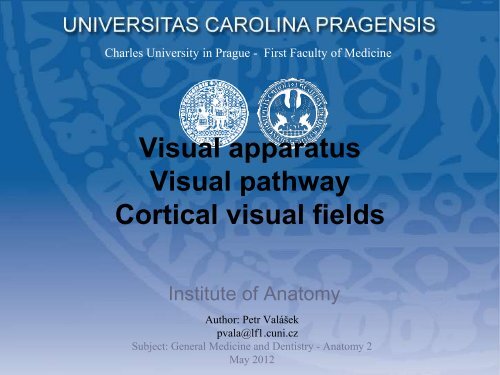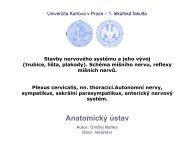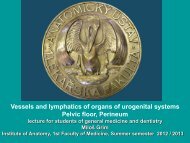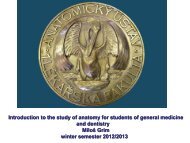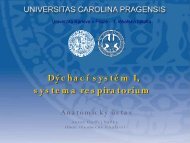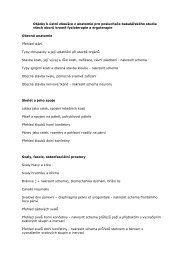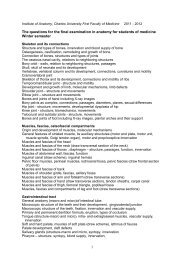Visual apparatus Visual pathway Cortical visual fields
Visual apparatus Visual pathway Cortical visual fields
Visual apparatus Visual pathway Cortical visual fields
You also want an ePaper? Increase the reach of your titles
YUMPU automatically turns print PDFs into web optimized ePapers that Google loves.
Charles University in Prague - First Faculty of Medicine<strong>Visual</strong> <strong>apparatus</strong><strong>Visual</strong> <strong>pathway</strong><strong>Cortical</strong> <strong>visual</strong> <strong>fields</strong>Institute of AnatomyAuthor: Petr Valášekpvala@lf1.cuni.czSubject: General Medicine and Dentistry - Anatomy 2May 2012
Structure of CNSWilliams P.L. (ed): Grays Anatomy, Churchill Livingstone, New York, 1995
Brain regionscortexbasal gangliathalamushypothalamusepithalamus - pineal glandpretectummetathalamus
33 & 48 h chick embryo
The development of the eye
http://www.siumed.edu/~dking2/ssb/EE015b.htm
Lens developmenthttp://www.dogstuff.info/lens_development_kral.html
The Fibrous Tunic• Most EXTERNAL layer of the eyeball• Composed of two regions of connective tissue• Sclera – posterior five-sixths of the tunic• White, opaque region• Provides shape and an anchor for 6 eye muscles• Cornea – anterior one-sixth of the fibrous tunic• Limbus – junction between sclera and cornea (stemcells)• Scleral venous sinus – allows aqueous humor todrain (Glaucoma! High eyeball pressure)Copyright © 2005 Pearson Education, Inc., publishing as Benjamin Cummings
VISUAL PATHWAY1.,2.,3. N – rods andcones, bipolar cells,ganglion cells (+ horizontaland amacrine).4. N – corpusgeniculatum laterale, tr.geniculo-corticalis(radiatio optica) to area175. N – cell in area 17(V 1)
The Sensory Tunic - RETINA• the DEEPEST layer• Composed of two layers•Pigmented layer – singlelayer of melanocytes•Neural layer – sheet ofnervous tissue• Contains three maintypes of neurons• Photoreceptor cells• Bipolar cells• Ganglion cellsFigure 16.10a
Regulation der KapillardurchblutungWiderstandsgefässe(Präkapilläre Sphinkteren)„Hauptweg“VenoleKapillarenPräkapilläre Sphinkteren offen
MaculaluteaWiliams P.L. (Ed) Gray´sAnatomy. ChurchillLivingstone, New York,1995
a.+v. centralis retinae
RETINA – macula lutea• Macula lutea – very few blood vessels, containsmostly cones• Its center - fovea centralis – contains only cones•Region of highest <strong>visual</strong> acuity• Optic disc – blind spot, where optic nerve leaves.Copyright © 2005 Pearson Education, Inc., publishing as Benjamin Cummings
BLIND SPOT
400-700nm
“red” or “L” cones long wavelength lightgreen” or “M” mediumCONES – colour visionTrichromatic theory - the comparison begins inthe retina ((optic nerve has only 1millionaxons)), where signals from “red” and “green”cones are compared by specialized red-greencells “opponent-process theory”.- compute the balance between red and greenlight coming from a particular part of the <strong>visual</strong>field Defect of one or more types of cones -COLOURBLINDNESS“blue” or “S” cones short
• Lateral inhibition is the reduction ofactivity in one neuron by activity inneighboring neurons.• responsible for heightening contrastin vision
The Photoreceptors:PHOTOTRANSDUCTION• Rods and cones contain photopigments- chemicalsthat release energy when struck by light.Photopigments consist of 11-cis-retinal(derivative of Vitamin A) which is bound to opsin (aprotein).Light converts 11-cis-retinal to all-trans-retinal,which ultimately activates 2 nd messenger systems thatwork to close Na+ channels, hyperpolarizing thereceptor.
The Photoreceptors:PHOTOTRANSDUCTIONPhotoreceptors input to retinal bipolar cells, which input to retinalganglion cells.Photoreceptors and bipolar cells do not produce action potentials. Theyproduce graded potentials.lightRetinal ganglion cells produce actionpotentials.
The Photoreceptors:PHOTOTRANSDUCTIONAt rest, (i.e. in the dark) photoreceptors continuously releaseneurotransmitter (glutamate).Glutamate hyperpolarizes some bipolar cells, and depolarizes otherbipolar cells.. . .. .in the darkSome bipolar cells provide hyperpolarizing input to ganglion cells, andsome bipolar cells provide depolarizing input.
Processing in the Retinal Ganglion CellEach ganglion cell ONLY responds to the presence or absence oflight in its receptive fieldReceptive field is the area of <strong>visual</strong>space to which a given cell responds•GGanglion cell receptive <strong>fields</strong> arecircular.Ganglion cell receptive <strong>fields</strong> have aconcentric antagonistic surround.on-center cells mostly excited bylight falling on the center of thereceptive fieldoff-center cell mostly excited bylight in the surround.
Geometric illusions
Retina-schemaWiliams P.L. (Ed) Gray´s Anatomy. Churchill Livingstone,New York,1995
<strong>Visual</strong> Pathways to the Cerebral Cortex• Light activates photoreceptors• Photoreceptors signal bipolarcells• Bipolar cells signal ganglion cells• Axons of ganglion cells exit eyeas the optic nerve• Optic nerve decussates atchiasma• Optic tract goes to lateralgeniculate nucleus of thethalamus (but some fibers tomidbrain for pupillary reflex,position and movements of theeye – unconscious)• Optic radiation reaches theprimary <strong>visual</strong> cortex (consciousseeing)
<strong>Visual</strong> Pathways to the Brain and <strong>Visual</strong> Fields - DEFECTSLGNThe primary <strong>visual</strong> cortex(area V1) receivesinformation from the lateralgeniculate nucleus and isthe area responsible for thefirst stage of <strong>visual</strong>processing.Some people with damageto V1 show blindsight, anability to respond to <strong>visual</strong>stimuli that they report notseeing.
Cortex - quadrantanopia(ischaemia in a.cerebri post.),cortical blindess, optical agnosia,dysmorfopsia, fosfens,halucinations<strong>Visual</strong> <strong>fields</strong>1 – amaurosis42 – nasal hemianopia (a.carotisinterna)3 – bitemporal hemianopia(hypophysis)4 – homonymous hemianopia
Corpus geniculatum lateralhttp://radiopaedia.org/articles/corpora-quadreigemina
Optical tractPetrovický et al.: Anatomie, IXCentrální nervový systém, Karolinum,Praha, 1995
4. N, section of corpus geniculatum lateraleCrossed fibers to 1., 4.,6.Uncrossed fibres to 2.,3., 5.
Lateral Geniculate Nucleus•(LGN) in the thalamus is the majortarget of the retinal ganglion cells.•It receives inputs from both eyesand relays these messages to theprimary <strong>visual</strong> cortex via the opticradiation.•Topographically organised.
Analysis of vision shape, colours, movement andposition in space. Occipital, temporal andparietal lobes.. Ca. 20 retinotopical maps.System of magnocellular tracts for analysis ofmovement in space, rough shape and contrast.Not colour sensitive.System of parvocellular tracts specializes ondetection of details and exact shape andcolours.
V1(Br17) – primary <strong>visual</strong> cortex,simple, retinotopic, perception of objectorientation and movementMST – V5, movement of objects,stereovision (binocular +monocular –decreasing size, loss of detail)… movementof eyesV2 - orientation, spatial frequency, and colourV4 – colour perception
Central Projections of the RetinaThe retina projects to foursubcortical regions in the brain:1) Lateral Geniculate nucleus2) Superior Colliculus3) Hypothalamus4) Pretectum
Branches of the <strong>visual</strong> <strong>pathway</strong> (all start from the 3.N.)~ To hypothalamus: optical input to vegetative system(circadian, season cycle)~ Pupillary reflexes:Miosis : via area pretectalis (AP=pretectum) to n. III (EW) -ganglion ciliare - nn. ciliares breves - m. ciliaris et m. sphincterpupillae (accommodation = same, but from AP via ncl.interstitialis Cajali)Mydriasis: via AP to reticular formation: tractus reticulospinalis -centrum ciliospinale C8-Th1 - ganglion cervicale superius -plexus caroticus internus et ophtalmicus - nn. ciliares breves - m.dilatator pupillaeConvergence: via AP to ncl. Cajali - FLM - nuclei of extraocularmuscles nerves~ Tectal <strong>visual</strong> circuit – tr. tectospin., - nuclearis, - interstitialis, crbl(coordination of the movements of the eye, head, neck (body)towards a <strong>visual</strong> stimulus)~ To pulvinar Th: coordination of <strong>visual</strong> and sensory inputs
Pupilární reflexPetrovický et al.:Anatomie, IXCentrální nervovýsystém, Karolinum,Praha, 1995Pupilar reflex
http://anthropotomy.com/assets/images/part3/116.jpg
Cranial nerve nuclei
gangl. cervicale ▪superiusnn. ciliares breves*Odbočky zezrakové dráhyDráhy pupilárníhoreflexu, dráhy proakomodaci akonvergenciakomodaceC8 – Th1▪·RF• NcI Cajali fasc.longit.med.,konvergence
Onion and contact lensesCorneal reflexNasociliary branch of the ophthalmic branch (V1) of the 5th cranial nerve (trigeminal nerve) sensing the stimulus on the cornea, lid, or conjunctiva7th cranial nerve (Facial nerve) initiating the motor response (i.e. it is the efferent)
Pupillary light reflex + accommodation reflexAnd accommodation
The Vascular Tunic - IRIS• Visible colored part of the eye• Attached to the ciliary body• Composed of smooth muscle• Pupil – the round, central opening• Sphincter pupillae muscle (constrictor or circular)PARASYMPATHETIC• Dilator pupillae muscle (dilator or radial)SYMPATHETIC (atropin – atropa bella-donna –mandragora)Copyright © 2005 Pearson Education, Inc., publishing as Benjamin Cummings
Pupillary dilation and constriction
The Eye as an Optical Device• Structures in the eye (lens, cornea, andhumors) bend light rays• Light rays converge on the retina at asingle focal point• Accommodation – curvature of the lensis adjustable - for focusing on nearbyobjects (blur-driven)
?????????-ocular reflex - the Extraocular muscles3 cranial nerves…smooth pursuit - track imagesaccadic - not apparent; move image to different receptors
Vestibulo-ocular reflex - the Extraocular muscles
ExtraocularmusclesWiliams P.L. (Ed) Gray´sAnatomy. ChurchillLivingstone, New York,1995
http://e-learning.studmed.unibe.chStrabismus
Senile macular degenerationhttp://www.lowvisionclub.comhttp://www.medrounds.org
Glaucomahttp://www.lowvisionclub.comhttp://137.222.110.150/calnet/<strong>Visual</strong>1/image/glaucoma-opthalmoscopic%20photo.jpg
Retinal amotionhttp://www.lexum.cz/vitroretinalni-choroby.php
Eyelid andconjunctivaWiliams P.L. (Ed) Gray´sAnatomy. ChurchillLivingstone, New York,1995
Lacrimal <strong>apparatus</strong>Wiliams P.L. (Ed) Gray´s Anatomy. ChurchillLivingstone, New York, 1995
Sjögrenův syndromhttp://www.dgrh.dehttp://edoc.hu-berlin.de


